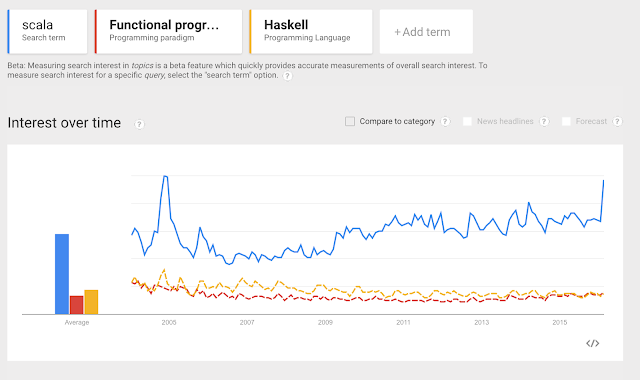The Scala symbolises “scalable language” and is a modern multi-paradigm and hybrid functional programming language. Its first version was released in 2003 by Martin Odersky, who is the developer of this programming language. This programming language has been designed to grow with its users’ demands and it means that Scala grows with you.
The Java Virtual Machine is used by Scala upon which it is compiled to run on it. There are many well-known companies relying on Java for the sole purpose of critical applications associated with business and all these are increasingly adopting this language with the core objective of enhancing the scalability of applications, development productivity and the reliability as a whole.
Learning scala programming is not a cake walk. Its takes a while to get used to functional programming paradigm. For beginners we recommend reading good scala books along with practice exercises recommended on interactive programming sites.
Scala is gaining popularity and here are some reasons that make it choice of many developers.
What Is Scala
Below is a simple playlist of tutorials that explains what is scala and why its needed.
The Goal of Scala at a Glance
The goal of Scala was to develop a sophisticated programming language that provides better support for component software. In this regard, two hypotheses were developed:
- Programming language needs to be scalable for component software
- The same notions illustrate small and large parts
- Instead of integrating countless primitives, the main concentration is on abstraction, composition, and decomposition
- Language that combines object-oriented programming and functional programming can give scalable assistance for components
Behold the following crucial and fabulous attributes, which make the programing language of Scala the highly desirable choice of the companies that are the application developers:
Scala Is Elegant
When it comes to exploring the features and other aspects of Scala languages then one of the main features of the Scala can be assumed as elegance. In a broader context, this language offers so much elegance as programmers are able to solve different kinds of real issues in an elegant manner. At the same time, Scala uses one of the most commonly used platforms such as JVM (Java Virtual Machine).
Object-Oriented
Everything looks like an object in Scala. Every value is an object and all the operations are the method-call and for this very reason, Scala is a pure object-oriented programming language, such as Java, Smalltalk, Python, Ruby, and others. The language has classes and traits that support and describe advanced component architectures, types and nature of objects.
In other languages, there are numerous conventional design patterns and these are already natively supported. One of the best examples here is singletons and visitors. Object definitions support singletons and pattern matching support visitors. Scala uses implicit classes and that’s why it is able to let the user to add more new operations to prevailing classes, and it does not matter where they come from, Scala or Java.
Functional
Scala is not only an object-oriented programming language, but it also a full-blown functional language. It is also functional as all the functions are a value as well as an object because every value is an object.
Scala is quite different from a wide variety of conventional programming languages that have functional nature. The reason behind this is that Scala allows a slow but steady and easy movement to a more functional style.
Runs on Java
Yes, Scala runs on Java by compiling into Java Byte Code which is performed by the Java Virtual Machine (JVM). The classes in both Scala and Java languages can be mixed very easily and freely, and it does not matter whether they exist indiverse or in projects.This nature of Scala points out that there is a common runtime platform in both languages.
Functions are Objects
The approach of Scala is exceptional and different as a set of core constructs is developed by it and such a set can be blended very flexibly, and this also applies to its two splendid features of object-orientation and functional. From both angles, features and attributes are amalgamated to an extent where these two natures of the language can be viewed as two different sides of the same coin.
Other Features of Scala in a Nutshell
- Scala is both functional and object-oriented at the same time
- every value is an object and every function is a value
- Scala immensely supports lightweight syntax for anonymous, higher-order and nested functions, and currying
- Support consistently for regular expression patterns
- ML-style pattern matching
- Integration with XML
- can write XML directly in Scala programming language
- can convert XML DTD into Scala class definitions
- Permits to define new structures to control devoid of using macros, while maintaining static typing
- Any type of function can be used as an infix or postfix operator
Popularity Of Scala on Google
In fact, Scala was especially designed with the core objective of being a more improved and better programming language, shedding such facets of Java which it considered restrictive.By exploring the above mentioned fabulous features, it seems that Scala programming language is the future of programming in any type of environment.
This article is contributed by John Kelly and Kate Silverton.
John Kelly is a professional and experienced blog writer as well education counsellor. Recently he joined with an essay writing service, Best Essay Point to provide assistance and guidance to the students regarding education career.
Kate Silverton is an experienced programmer by profession and these days she is associated with DissertationHelpLove renowned academy house. Apart from her professional commitments, she takes time in order to interact with different programmers on various social media platforms so that they can attain updated information about different programming languages in a better way.

